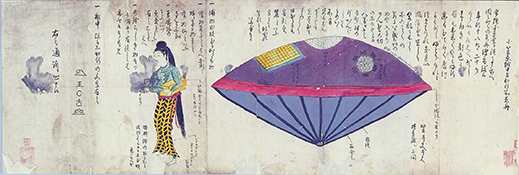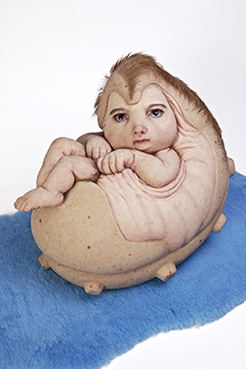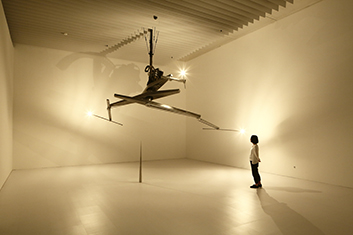 |
Focus features two in-depth reviews each month of fine art, architecture and design exhibitions and events at art museums, galleries and alternative spaces around Japan. The contributors are non-Japanese art critics living in Japan. |
|
|
 |
 |
 |
A Universal Art Journey
Lucy Birmingham |
 |
teamLab, Crows Are Chased and the Chasing Crows Are Destined to Be Chased as Well, Blossoming on Collision - Light in Space (2016). Interactive digital installation, 4 min. 20 sec. Sound: Hideaki Takahashi |
|
Mandala of the Two Realms (14th century). One of a pair of hanging scrolls, color on silk, 235.5 x 197.2 cm each. Collection: Mimuroto-ji temple, Kyoto |
The universe has been an artistic muse for humankind since, well, art began. Paleolithic cave paintings in France and Spain depict what scientists interpret as astronomical star clusters in the night sky. In Japan, the cosmos and a Chinese myth likely inspired "The Tale of the Bamboo Cutter" (Taketori monogatari), a 10th-century science-fiction narrative featuring the beautiful Princess Kaguya, who came from the Moon.
"Moonstruck" was one viewer's response when seeing the tale reproduced as an Edo-period (1603-1867) 13-meter pictorial scroll in The Universe and Art, an exhibition now at the Mori Art Museum in Tokyo. The hand-painted narration is part of a dizzying display of about 200 items in four sections spanning ancient to contemporary eras. Right. Amassing an art exhibition on the universe is no easy matter.
 |
|
Manjudo, The Strange Boat Drifted Ashore on Fief of Lord Ogasawara, from Hyoryu-ki-shu (Archives of Castaways) (19th century). Book, approx. 26 x 77 cm.
Collection: Iwase Bunko Library, Nishio, Aichi |
Fortunately, this cosmic art journey does not start with the Big Bang, the beginning of it all. Instead, Section 1 propels us through the somewhat more recent past, assisted by an astronomical clock based on traditional Buddhist cosmology. First stop: astronomy through the eyes of the spiritual world, illustrated by breathtaking Buddhist mandalas dating from the 1200s. A few steps away we meet Princess Kaguya, the mythical space alien, followed by a cornucopia of items reflecting ways humans have viewed the universe through the ages. Among these are ancient mirrors; contemporary Moon figurations under wax; Japanese sunspot observation diagrams; a Japanese sword forged from meteorite iron; and astronomy and mathematics manuscripts by Leonardo, Galileo, Newton and other great thinkers.
In Section 2 we move forward in space-time to reach the late-20th and 21st centuries. Installations, sculpture and photography predominate. Celebrated photographer Wolfgang Tillmans reveals his childhood enthusiasm for astronomy with an installation of eight photos he created for the exhibition. Mariko Mori adds her years of study and experiments with space themes in two sculptures. And Chinese artist Jia Aili captivates with oil paintings of nightmarish, stormy landscapes thrashed by lightning. Up close, his central Untitled work appears to carry a subtle but powerful message about the Cultural Revolution practice of brainwashing children. Conrad Shawcross's installation Timepiece is a literal standout, hanging from the ceiling and hypnotizing viewers as it gracefully employs mechanical engineering to play with time. So how does it tick? The sculptor's interest in robotics may offer a clue to the mystery.
 |
|
 |
|
Patricia Piccinini, The Rookie (2015). Fiberglass, silicone, hair, 48 x 65 x 46 cm.
Collection of the artist. Courtesy: Tolarno Galleries, Melbourne; Roslyn Oxley9 Gallery, Sydney; Hosfelt Gallery, San Francisco |
|
Konstantin Tsiolkovsky, Drawing from the manuscript Album of Cosmic Journeys (1933). Pencil on paper, 31.1 x 22.7 cm. Collection: The Archive of the Russian Academy of Sciences (ARAS) |
Mysteries rule in Section 3 with a look at extraterrestrial life, space aliens, and UFOs. Sci-fi fans, though, may be disappointed. There's plenty of history, science, and speculation about humanity's future, but we crave some storytelling. A series of vintage SF magazine covers from the 1930s and 1940s whet our appetite for contemporary versions. Momoko Seto's Planet Σ (Epsilon) tale -- a remarkable time-lapse video -- gives us an unforgettable taste of the extraterrestrial with insect protagonists. Science fiction's role in spotlighting tech and medical controversies is addressed. Patricia Piccinini bravely takes on genetic engineering with one of her freakishly cute alien-like sculptures. Vincent Fournier's Robotic Jellyfish Drone, made with a 3D printer, and Hajime Sorayama's Sexy Robot reference new technology, but strong examples of artificial intelligence are sorely needed. A truly eye-popping work is the series of Edo-period sketches and writings about a mysterious spherical "hollow ship" (i.e., UFO) that drifted ashore in 1803 on the coast of what is now Ibaraki Prefecture.
Will UFO-riding aliens of the future be humans? Advances in space travel will surely take us to meet unimaginable life forms at greater and greater distances. Part 4 follows the giant steps taken in space race history, and spotlights the Moon as a platform for exploration and experimentation.
 |
|
 |
|
Sputniko!, The Moonwalk Machine - Selena's Step (2013). Video, 5 min. 4 sec. Photo: Rai Royal. Photo courtesy: SCAI The Bathhouse |
|
Installation view of three works by Jia Aili, from left to right: Hermit from the Planet Dust (2015-2016), oil on canvas, 400 x 600 cm; Untitled (2015), oil on canvas, 156 x 134 cm; Untitled (2008-2012), oil on canvas, 170 x 207 cm. Collection of the artist. Photo: Keizo Kioku |
NASA's 1969 photo "Neil Armstrong's Footprint on the Moon" emblematizes America's most noted space-race win. Photos of Russia's space program in 1961 recall that country's pioneering successes. Fascinating drawings from 1878 to 1933 by Russia's "father of rocketry" -- scientist Konstantin Tsiolkovsky -- introduce the original genius behind the Soviet rockets. Tom Sachs's replica of the ill-fated Space Shuttle Challenger reminds us of the dangers of space flight then and now. TeamLab's interactive digital installation, commissioned for the show, highlights the art collective's astounding works. The wearable "space gear" designed by Neri Oxman elicited comments like "creepy" and "weird" from some viewers, but the two works are a marriage of beauty and function for life -- on Saturn.
Last but not least is MAM Screen 004: Watching the Earth from the Universe, with 13 videos on subjects as diverse as geopolitics, gender, and aliens. Artist/designer and MIT Media Lab assistant professor Hiromi Ozaki, better known as Sputniko!, shows her well-known The Moonwalk Machine - Selena's Step. The work is a satirical stomp on the politicized U.S. Apollo space program (think Neil Armstrong in high heels), with a science-geek girl protagonist who dreams of becoming the super heroine "Lunar Girl" (visualize a 21st-century Princess Kaguya). More of Momoko Seto's stunning time-lapse videos appear in this section. Here, she gets ultra-close with macro shots of Planet A (crystals melting) and Planet Z (vegetables decomposing), referencing the micro-beginnings of planetary life.
Human life on distant planets will be possible someday, scientists say. Space scientist and educator Yasunori Matogawa commented during a MAM seminar that it is our quest for freedom that will drive us there. "But to gain that freedom, science, technology, and art need to collaborate," he said, adding, "I've never seen an exhibition like this before. It can inspire us to collaborate." To quote Star Trek's Mr. Spock: "For everything, there is a first time."
 |
|
 |
|
Installation view of Conrad Shawcross, Timepiece (2013). Aluminum, steel, mechanical system, lights; dimensions variable. Photo: Keizo Kioku |
|
Installation view of Sorayama Hajima, Sexy Robot (2016). FRP, iron, silver, gold plating air brush paint, LED neon light, 182 x 60 x 60 cm. Photo: Keizo Kioku |
All images courtesy of the Mori Art Museum, Tokyo. |
 |
 |
Lucy Birmingham
Lucy Birmingham is a long-time, Tokyo-based journalist, scriptwriter, author, and former photojournalist. She recently served two years as president of the Foreign Correspondents' Club of Japan. She has written regularly for TIME magazine and her articles have appeared in many publications, including the Wall Street Journal, Newsweek, Bloomberg News, and Architectural Digest. As an arts and culture writer her articles have appeared in publications including Artinfo.com, Artforum.com, and ARTnews. She is also a scriptwriter and narrator for NHK (Japan's public broadcaster) and has published several books including Strong in the Rain: Surviving Japan's Earthquake, Tsunami, and Fukushima Nuclear Disaster. lucybirmingham.com |
|
 |
|